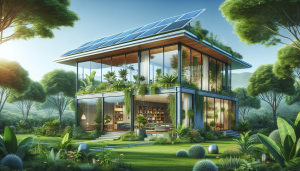In today’s world, where sustainability is paramount, understanding the role of Life Cycle Assessment (LCA) in sustainable architecture is crucial. In our article, “What Is The Role Of Life Cycle Assessment In Sustainable Architecture?” we dive into how LCA helps builders, designers, and architects evaluate the environmental impacts of construction materials and processes from cradle to grave. By embracing this holistic assessment, together, we can make more informed decisions that reduce our carbon footprint and promote a more sustainable future in the built environment. Join us as we explore the importance and implementation of LCA in creating eco-friendly and resilient architectural solutions. Have you ever wondered how we can truly measure and achieve sustainability in the architecture world? The key might lie within a fascinating process known as Life Cycle Assessment (LCA). Let’s delve into what LCA is and discover its integral role in sustainable architecture.
Understanding Life Cycle Assessment (LCA)
What is Life Cycle Assessment?
Life Cycle Assessment, or LCA, is an analytical method used to evaluate the environmental impacts of materials, products, or buildings over their entire life cycle. From cradle to grave—or sometimes cradle to cradle—LCA helps us understand the full extent of ecological footprints, be it the initial extraction of raw materials, through production, use, and eventual disposal or recycling.
The Phases of LCA
LCA comprises four main phases:
- Goal and Scope Definition: Establishing the purpose and the system boundaries.
- Life Cycle Inventory (LCI) Analysis: Collecting data on energy, material inputs, and environmental releases.
- Life Cycle Impact Assessment (LCIA): Evaluating the potential environmental impacts derived from the LCI.
- Interpretation: Analyzing the results to make informed decisions.
These phases provide a structured path to thoroughly assess and minimize the environmental impacts of our architectural projects.
The Role of LCA in Sustainable Architecture
Comprehensive Environmental Evaluation
In the context of sustainable architecture, LCA acts as a tool to perform a comprehensive evaluation of environmental impacts associated with building materials and design choices. By understanding these impacts, we can make more informed decisions that align with sustainability goals.
Reducing Carbon Footprint
One of the primary aims of sustainable architecture is to reduce the carbon footprint of buildings. LCA helps us identify the high-impact phases of a building’s life and implement strategies to minimize emissions. For example, using low-carbon construction materials or optimizing energy efficiency during the building’s use phase.
Optimizing Resource Use
Efficient resource use is another critical component of sustainability. LCA aids in selecting materials that offer the best environmental performance from a resource consumption perspective. This might include choosing renewable materials, recycling existing resources, or employing innovative construction techniques that require less raw material.
Enhancing Durability and Longevity
By evaluating the full life cycle, LCA ensures that we pay attention to the durability and longevity of building materials and structures. Buildings that last longer and require less frequent renovation and replacement contribute significantly to sustainability by reducing waste and resource use over time.
Applying LCA in Architectural Design
Material Selection
Using LCA in material selection helps us compare various options’ environmental impacts. For instance, we might find that recycled steel has a lower environmental footprint compared to newly manufactured steel, or that locally-sourced timber might be preferable due to lower transportation emissions.
Energy Efficiency
LCA can assist in designing energy-efficient buildings by modeling the energy consumption of different design solutions over the building’s life. This way, we can prioritize solutions that provide the best environmental benefits, such as advanced insulation, optimized glazing, and energy-efficient HVAC systems.
Waste Management
Effective waste management is crucial in sustainable architecture. LCA guides us in selecting materials and construction techniques that produce less waste, and it also helps plan for the building’s end-of-life phase, where demolition waste can be minimized or materials can be recycled.
Benchmarking Performance
LCA enables us to benchmark the environmental performance of our buildings against established standards and certifications, such as LEED or BREEAM. This benchmarking helps set clear sustainability targets and track progress over time.
Benefits of Using LCA
Improved Decision-Making
By providing detailed insights into the environmental impacts of our choices, LCA enhances our decision-making process. We can weigh different factors, such as energy use, emissions, and resource consumption, to make choices that align with our sustainability objectives.
Transparent Communication
LCA offers a transparent framework for communicating the environmental benefits of our buildings to stakeholders. Whether it’s clients, regulators, or the general public, we can clearly demonstrate how our design choices contribute to sustainability efforts.
Regulatory Compliance
Many regions and countries are introducing stricter environmental regulations for buildings. Implementing LCA helps us stay ahead of these regulations and ensure compliance, avoiding potential legal issues and penalties.
Market Differentiation
In an increasingly competitive market, having a robust approach to sustainability through LCA can differentiate our projects. This can attract environmentally-conscious clients and provide a competitive edge in bids and tenders.
Challenges and Limitations of LCA
Data Availability
One of the common challenges in conducting LCA is the availability and quality of data. Accurate LCA relies on detailed and reliable data about material properties, production processes, and usage patterns, which can sometimes be difficult to source.
Complexity of Assessment
LCA can be a complex and time-consuming process, requiring specialized knowledge and software tools. This complexity might pose challenges for smaller projects or teams without dedicated sustainability professionals.
Scope Definition
Defining the scope of an LCA can be tricky, especially in determining system boundaries and relevant impacts to include. A too narrow or too broad scope can either miss significant impacts or overwhelm the analysis with excessive information.
Dynamic Factors
Building materials and technologies are continuously evolving, which means that LCA results can quickly become outdated. Regular updates and re-assessment are necessary to keep LCA results relevant and accurate.
Future of LCA in Sustainable Architecture
Integration with BIM
Building Information Modeling (BIM) is revolutionizing the way we design and construct buildings. Integrating LCA with BIM systems can streamline the assessment process, making it easier to evaluate environmental impacts throughout the design phase.
Advances in Materials Science
Ongoing advances in materials science are likely to provide new low-impact materials that can be assessed through LCA. These materials, coupled with innovative construction methods, hold the potential to further reduce the environmental footprint of buildings.
Policy and Incentives
As governments and organizations worldwide continue to prioritize sustainability, we can expect more policies and incentives supporting the use of LCA. This support can drive wider adoption and more comprehensive integration into standard architectural practices.
Collaborative Platforms
Emerging collaborative platforms and databases can enhance data sharing and improve the accuracy and accessibility of LCA results. These platforms can enable architects, engineers, and sustainability professionals to work together more effectively.
Conclusion
Life Cycle Assessment is undeniably a powerful tool in our quest for sustainable architecture. By providing a comprehensive understanding of the environmental impacts associated with building materials and design choices, LCA enables us to make responsible decisions that align with our sustainability goals. Despite its challenges and complexities, the benefits of using LCA—ranging from improved decision-making to market differentiation—are substantial and compelling.
As we continue to innovate and integrate LCA with advanced technologies like BIM and sustainable materials, the future of sustainable architecture looks promising. LCA not only helps us build greener and more efficient structures but also fosters a culture of environmental responsibility and transparency.
So, next time we embark on an architectural project, let’s remember the invaluable role of Life Cycle Assessment in shaping a sustainable future for our built environment. Together, we can create buildings that not only meet our functional needs but also resonate with our commitment to protecting our planet.
Thank you for joining us on this exploration of Life Cycle Assessment in sustainable architecture. We hope you found this journey enlightening and inspiring. Let’s build a sustainable world, one project at a time!




